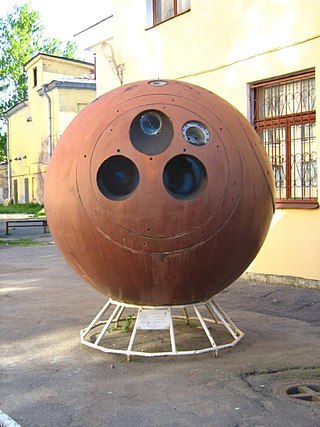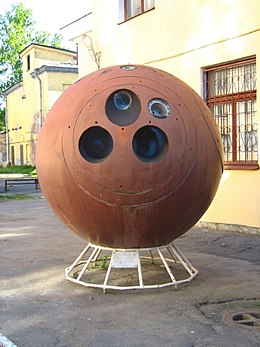
Kosmos 9, also known as Zenit-2 No.5, was a Soviet reconnaissance satellite launched in 1962. It was the ninth satellite to be designated under the Kosmos system, and the third successful launch of a Soviet reconnaissance satellite, following Kosmos 4 and Kosmos 7.

Kosmos 10, also known as Zenit-2 No.6, was a Soviet reconnaissance satellite launched in 1962. It was the tenth satellite to be designated under the Kosmos system, and the fourth successful launch of a Soviet reconnaissance satellite, following Kosmos 4, Kosmos 7 and Kosmos 9.

Kosmos 15 or Zenit-2 No.9 was a Soviet optical film-return reconnaissance satellite which was launched in 1963. A Zenit-2 spacecraft, Kosmos 15 was the ninth of eighty-one such satellites to be launched.

Kosmos 16 or Zenit-2 No.10 was a Soviet optical film-return reconnaissance satellite which was launched in 1963. A Zenit-2 satellite, Kosmos 16 was the tenth of eighty-one such spacecraft to be launched.

Kosmos 20 or Zenit-2 No.13 was a Soviet optical film-return reconnaissance satellite which was launched in 1963. A Zenit-2 satellite, Kosmos 20 was the thirteenth of eighty-one such spacecraft to be launched.

Kosmos 29 or Zenit-2 No.17 was a Soviet, a first generation, low resolution, optical film-return reconnaissance satellite which was launched in 1964. A Zenit-2 spacecraft, Kosmos 29 was the seventeenth of eighty-one such satellites to be launched and had a mass of 4,780 kilograms (10,540 lb).

Kosmos 32 or Zenit-2 No.18 was a Soviet, first generation, low resolution, optical film-return reconnaissance satellite which was launched in 1964. A Zenit-2 spacecraft, Kosmos 32 was the eighteenth of eighty-one such satellites to be launched and had a mass of 4,730 kilograms (10,430 lb).

Kosmos 33 or Zenit-2 No.19 was a Soviet, first generation, low resolution, optical film-return reconnaissance satellite launched in 1964. A Zenit-2 spacecraft, Kosmos 33 was the nineteenth of eighty-one such satellites to be launched and had a mass of 4,730 kilograms (10,430 lb).

Kosmos 35 or Zenit-2 No.20 was a Soviet, first generation, low resolution, optical film-return reconnaissance satellite launched in 1964. A Zenit-2 spacecraft, Kosmos 35 was the twentieth of eighty-one such satellites to be launched and had a mass of 4,730 kilograms (10,430 lb).

Kosmos 37 or Zenit-2 No.21 was a Soviet, first generation, low resolution, optical film-return reconnaissance satellite launched in 1964. A Zenit-2 spacecraft, Kosmos 37 was the twentieth of eighty-one such satellites to be launched and had a mass of 4,730 kilograms (10,430 lb).

Kosmos 52 or Zenit-2 No.25 was a Soviet, first generation, low resolution, optical film-return reconnaissance satellite launched in 1965. A Zenit-2 spacecraft, Kosmos 52 was the twenty-fifth of eighty-one such satellites to be launched and had a mass of 4,730 kilograms (10,430 lb).

Kosmos 68 or Zenit-2 No.28 was a Soviet, first generation, low resolution, optical film-return reconnaissance satellite launched in 1965. A Zenit-2 spacecraft, Kosmos 68 was the twenty-eighth of eighty-one such satellites to be launched and had a mass of 4,730 kilograms (10,430 lb).

Kosmos 78 or Zenit-2 No.30 was a Soviet, first generation, low resolution, optical film-return reconnaissance satellite launched in 1965. A Zenit-2 spacecraft, Kosmos 78 was the thirtieth of eighty-one such satellites to be launched and had a mass of 4,730 kilograms (10,430 lb).

Kosmos 98 or Zenit-2 No.31 was a Soviet, first generation, low resolution, optical film-return reconnaissance satellite launched in 1965. A Zenit-2 spacecraft, Kosmos 98 was the thirty-first of eighty-one such satellites to be launched and had a mass of 4,730 kilograms (10,430 lb).

Kosmos 104 or Zenit-2 No.33 was a Soviet first-generation low-resolution optical film–return reconnaissance satellite launched in 1966. A Zenit-2 spacecraft, Kosmos 104 was the thirty-second of eighty-one such satellites to be launched and had a mass of 4,730 kilograms (10,430 lb).

Kosmos 105 or Zenit-2 No.34 was a Soviet, first generation, low resolution, optical film-return reconnaissance satellite launched in 1966. A Zenit-2 spacecraft, Kosmos 105 was the thirty-fourth of eighty-one such satellites to be launched and had a mass of 4,730 kilograms (10,430 lb).

Kosmos 107 or Zenit-2 No.35 was a Soviet, first generation, low resolution, optical film-return reconnaissance satellite launched in 1966. A Zenit-2 spacecraft, Kosmos 107 was the thirty-fifth of eighty-one such satellites to be launched and had a mass of 4,730 kilograms (10,430 lb).

Kosmos 115 or Zenit-2 No.37 was a Soviet, first generation, low resolution, optical film-return reconnaissance satellite launched in 1966. A Zenit-2 spacecraft, Kosmos 115 was the thirty-seventh of eighty-one such satellites to be launched and had a mass of 4,730 kilograms (10,430 lb).
Kosmos 143 or Zenit-2 No.45 was a Soviet, first generation, low resolution, optical film-return reconnaissance satellite launched in 1967. A Zenit-2 spacecraft, Kosmos 143 was the forty-sixth of eighty-one such satellites to be launched and had a mass of 1,730 kilograms (3,810 lb).
Kosmos 147 or Zenit-2 No.44 was a Soviet, first generation, low resolution, optical film-return reconnaissance satellite launched in 1967. A Zenit-2 spacecraft, Kosmos 147 was the forty-seventh of eighty-one such satellites to be launched. and had a mass of 4,000 kilograms (8,800 lb).

